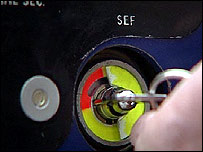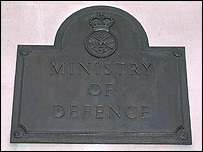Manticore
RETIRED MOD

- Joined
- Jan 18, 2009
- Messages
- 10,115
- Reaction score
- 114
- Country
- Location
http://www.defence.pk/forums/pakist...or-arms-control-disarmament-affairs-acda.html
-----
btw on the flip side
-----
btw on the flip side
British nukes were protected by bike locks
By Meirion Jones
Newsnight producer

How to arm a bomb
Newsnight has discovered that until the early days of the Blair government the RAF's nuclear bombs were armed by turning a bicycle lock key.
There was no other security on the Bomb itself.
While American and Russian weapons were protected by tamper-proof combination locks which could only be released if the correct code was transmitted, Britain relied on a simpler technology.
The Dr Strangelove scenario
The British military resisted Whitehall proposals to fit bombs with Permissive Action Links - or PALs - which would prevent them being armed unless the right code was sent.

UK nuclear weapons are designed first and foremost to be secure and safe

Read the MoD statement
PALs were introduced in the 1960s in America to prevent a mad General or pilot launching a nuclear war off their own bat - the Dr Strangelove scenario.
President Kennedy ordered that every American nuclear bomb should be fitted with a PAL.
The correct code had to be transmitted by the US Chiefs of Staff and dialled into the Bomb before it could be armed otherwise it would not detonate.
Safeguards
Crews in missile silos also had a dual key arrangement so one man could not launch Armageddon.
Similar safeguards are in place on Russian nuclear weapons.
They are familiar from numerous Hollywood films such as Broken Arrow with John Travolta, The Peacemaker with Nicole Kidman and various James Bond films.
Under control
Papers at the National Archive show that as early as 1966 an attempt was made to impose PAL security on British nuclear weapons.
The Chief Scientific Adviser Solly Zuckerman formally advised the Defence Secretary Denis Healey that Britain needed to install Permissive Action Links on its nuclear weapons to keep them safe.
"The Government will need to be certain that any weapons deployed are under some form of 'ironclad' control".
The Royal Navy argued that officers of the Royal Navy as the Senior Service could be trusted:
"It would be invidious to suggest... that Senior Service officers may, in difficult circumstances, act in defiance of their clear orders".
Neither the Navy nor the RAF installed PAL protection on their nuclear weapons.
The RAF kept their unsafeguarded bombs at airbases until they were withdrawn in 1998.
Bicycle lock key
With the help of Brian Burnell - a researcher into the history of the British nuclear weapons programme who once designed bomb casings for atom bombs - Newsnight tracked down a training version of the WE 177 nuclear bomb at the Bristol Aero collection at Kemble.
Tornado and earlier V-bomber crews trained with these, which were identical in every way to the live bombs except for the nuclear warhead.
To arm the weapons you just open a panel held by two captive screws - like a battery cover on a radio - using a thumbnail or a coin.
Inside are the arming switch and a series of dials which you can turn with an Allen key to select high yield or low yield, air burst or groundburst and other parameters.
The Bomb is actually armed by inserting a bicycle lock key into the arming switch and turning it through 90 degrees. There is no code which needs to be entered or dual key system to prevent a rogue individual from arming the Bomb.
This report can be seen on Newsnight on Thursday, 15 November, 2007 at 10.30pm on BBC TWO
BBC NEWS | Programmes | Newsnight | British nukes were protected by bike locks






